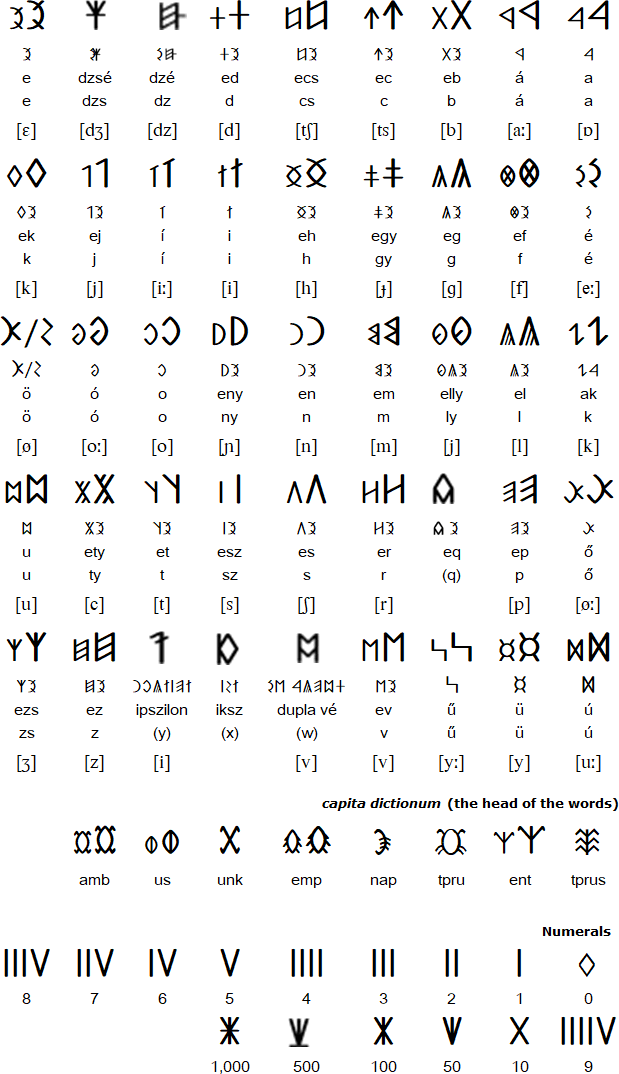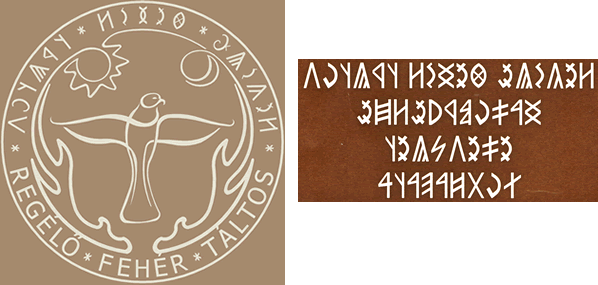Székely-Hungarian Rovás, which are also known as Hungarian Runes, are thought to have descended from the Turkic script (Kök Turki) used in Central Asia, though some scholars believe the Székely-Hungarian Rovás pre-date the Turkic script. They were used by the Székler Magyars in Hungary until the 11th century. In remote parts of Transylvania however, the runes were still used up until the 1850s. During the 20th century there was a revival of interest in the alphabet.
Hungarian (Magyar), a Uralic language with about 15 million speakers in Hungary, Romania, Serbia, Ukraine and Slovakia. There are also many people of Hungarian origin in the UK and other European countries, the USA, Canada and Australia.

Download an alphabet chart for Székely-Hungarian Rovás (Excel)

(Ezt) az Úr születése utáni 1501. évben írták. Mátyás, János, István kovácsok csinálták. Mátyás mester (és) Gergely mester csinálták [uninterpretable].
(This) was written in the 1501st year of our Lord. The smiths Matthias, John (and) Stephen did (this). Master Matthias (and) Master Gergely did [uninterpretable]
Source: http://en.wikipedia.org/wiki/Old_Hungarian_script

Feher Taltos Traditional Hungarian Drummers (Regélő Fehér Táltos)
Information about Hungarian | Székely-Hungarian Rovás (Hungarian Runes) | Phrases | Numbers | Time | Tongue twisters | Tower of Babel | Learning materials
Information about Székely-Hungarian Rovás
http://en.wikipedia.org/wiki/Old_Hungarian_script
http://wiki.rovas.info
http://www.solyommadar.hu
http://books.google.com/books?id=TyK8azCqC34C&pg=PA177&hl=hu&source=gbs_toc_r&cad=3#v=onepage&q&f=false
A-chik Tokbirim, Adinkra, ADLaM, Armenian, Avestan, Avoiuli, Bactrian, Bassa (Vah), Beitha Kukju, Beria (Zaghawa), Borama / Gadabuursi, Carian, Carpathian Basin Rovas, Chinuk pipa, Chisoi, Coorgi-Cox, Coptic, Cyrillic, Dalecarlian runes, Elbasan, Etruscan, Faliscan, Fox, Galik, Georgian (Asomtavruli), Georgian (Nuskhuri), Georgian (Mkhedruli), Glagolitic, Global Alphabet, Gothic, Greek, Hurûf-ı munfasıla, Irish (Uncial), Kaddare, Kayah Li, Khatt-i-Badí’, Khazarian Rovas, Koch, Korean, Latin, Lepontic, Luo Lakeside Script, Lycian, Lydian, Manchu, Mandaic, Mandombe, Marsiliana, Medefaidrin, Messapic, Mongolian, Mro, Mundari Bani, Nag Chiki, Naasioi Otomaung, N'Ko, North Picene, Novo Tupi, Nyiakeng Puachue Hmong, Odùduwà, Ogham, Old Church Slavonic, Oirat Clear Script, Ol Chiki (Ol Cemet' / Santali), Old Italic, Old Nubian, Old Permic, Ol Onal, Orkhon, Osage, Oscan, Osmanya (Somali), Pau Cin Hau, Phrygian, Pollard script, Runic, Székely-Hungarian Rovás (Hungarian Runes), South Picene, Sutton SignWriting, Sunuwar, Tai Viet, Tangsa, Todhri, Toto, Umbrian, (Old) Uyghur, Wancho, Yezidi, Zoulai
Page last modified: 15.03.23
[top]
You can support this site by Buying Me A Coffee, and if you like what you see on this page, you can use the buttons below to share it with people you know.

If you like this site and find it useful, you can support it by making a donation via PayPal or Patreon, or by contributing in other ways. Omniglot is how I make my living.
Note: all links on this site to Amazon.com, Amazon.co.uk
and Amazon.fr
are affiliate links. This means I earn a commission if you click on any of them and buy something. So by clicking on these links you can help to support this site.
[top]